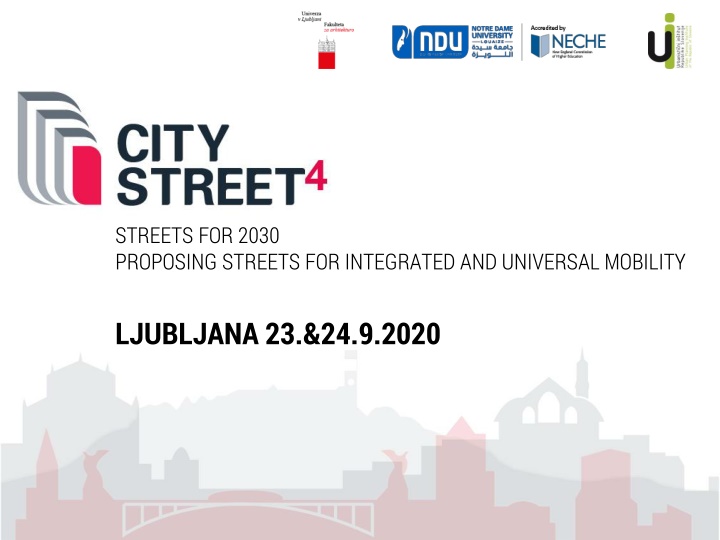
Proposing Streets for Integrated and Universal Mobility in Ljubljana 2030
Discover how the STREETS FOR 2030 initiative aims to address challenges of traffic volume and CO2 emissions in Alpine territories, with a focus on advancing low-carbon mobility strategies. Learn about the solutions offered by the ASTUS project to promote sustainable development through long-term low CO2 options in urban planning. Explore demographic and spatial trends impacting transportation and mobility in Novo Mesto and beyond.
Download Presentation

Please find below an Image/Link to download the presentation.
The content on the website is provided AS IS for your information and personal use only. It may not be sold, licensed, or shared on other websites without obtaining consent from the author. If you encounter any issues during the download, it is possible that the publisher has removed the file from their server.
You are allowed to download the files provided on this website for personal or commercial use, subject to the condition that they are used lawfully. All files are the property of their respective owners.
The content on the website is provided AS IS for your information and personal use only. It may not be sold, licensed, or shared on other websites without obtaining consent from the author.
E N D
Presentation Transcript
STREETS FOR 2030 PROPOSING STREETS FOR INTEGRATED AND UNIVERSAL MOBILITY LJUBLJANA 23.&24.9.2020
SIMON KOBLAR Urban Planning Institute of the Republic of Slovenia ADVANCING LOW CARBON MOBILITY IN SLOVENIA: THE CASE OF THE CITY MUNICIPALITY OF NOVO MESTO ANDREJ GULI , SERGEJA PRAPER GULI , SIMON KOBLAR
Results from ASTUS project ASTUS aimed to help local authorities to identify and implement long term solutions in both mobility and spatial planning and to reduce the CO2 impacts linked to daily trips in the Alps.
CHALLENGES Alpine territories are very attractive for touristic, economic and housing reasons. An increase in traffic volume and higher levels of CO2 emissions are challenges of the future.
CHALLENGES The spreading of housing and car-dependent structures often compels inhabitants to use their own car for daily trips. This has negative consequences from an environmental, economic, spatial and social perspective, and contradicts the sustainable development of alpine space.
SOLUTIONS ASTUS assists local authorities in identifying and adopting an adequate local low CO2 strategy and action plan, to foster long term low CO2 options.
PROCESS trends scenarios strategy actions for low carbon mobility and transport
DEMOGRAPHIC TRENDS 1. Population growth, especially in settlements located near the city of Novo mesto 2. Without a strong increase in fertility, the decline in births will get stronger 3. Strengthened decline of internal immigration into the municipality 4. Increase in education level 5. Smaller housholds
SPATIAL TRENDS 1. Dispersal of settlements 2. The traditional settlement patterns are being dissolved with the suburban 3. Continued interweaving of rural and suburban features within settlements 4. The trend of accelerated motorization continues 5. Changing habits of young people
TRENDS IN TRANSPORT AND MOBILITY 1. Worsening conditions for long distance passenger transport 2. Strengthening pressures on the environment from human activities 3. Downward trend in bus service supply 4. Increases in the number of alternative-fuel vehicles
DRIVING FORCES 1. Decline in the public transport services competitiveness 2. Decrease in the number of public transport passengers 3. Continuing pressures for dispersed settlement development in the suburban areas 4. Increasing of the motorization rate 5. Strengthening automobility 6. Increasing of greenhouse gas emissions from transport
SCENARIO BUILDING PROCESS ELEMENTS OF THE LOW CARBON SCENARIOS
STRATEGIC OBJECTIVES 1. Updated fleets of passenger cars and public transport vehicles. 2. A well-provisioned city (with economic public infrastructure). 3. High-quality living conditions have been established in the well-provisioned city. 4. Important extra-urban settlements are revived. 5. Highly developed public passenger transport. 6. Well-functioning urban rail passenger services. 7. Updated existing and built new road infrastructure.
CONCLUSIONS Project ASTUS have helped the City Municipality of Novo mesto with new insights and knowledge in the field of resolving joint problems of spatial development and transport mobility at the local level.
